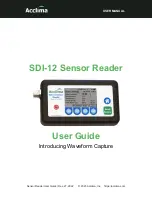
Registers, Data Formats, & Queries
Appendix D
D-12
NetScan User’s Manual
Register Chart
Status and Event Reporting
Registers
Command Type
Register
Access
Read
Write
Clear
CSR
Calibration Status
Read/Clear
U2
N/A
U2
ESC
Error Source
Read/Clear
E?
N/A
E?
ESR
Event Status
Read/Clear
U0
N/A
U0
STB
Status Byte
Read
U1
N/A
N/A
Register Chart
Mask Registers
Command Type
Register
Access
Read
Write
Clear
ESE
Event Status
Enable
Read/Write/
Clear
N?
Nmmm
(See
Note)
N0
SRE
Service Request
Enable
Read/Write/
Clear
M?
Mmmm
(See
Note)
M0
Note: The mmm defines the contents of the register to be written.
Theory of Operation
The following figure shows the general operation and relationship between the status reporting and mask
registers. Each register is part of a hierarchy of registers where operations on higher registers will affect the
contents of lower registers in the chain. This hierarchical approach provides the ability to have varying levels of
status reporting. The lowest levels give general status information while the higher levels give more details of
the particular events in question.
At the lowest level in this chain is the Status Byte Register. This allows quick response of certain critical
operational status conditions contained in the Status Byte Register (STB). However, since this register is the
lowest register in the chain, every other status register in the system, either directly or indirectly, has access to
the STB register via the Event Status Register Bit (ESB) in the STB register. This gives these other status
registers the ability (although not detailed) to quickly report their status to the controller.
The Event Status Enable (ESE) Register may be used to define which bits in the Event Status Register will be
mapped into the Event Status Register Bit (ESB) in the STB. The bits in the ESE represent an exact image of
the bits in the ESR. When a condition is set in the ESR its image bit is checked in the ESE. If enabled the ESB
bit in the STB is set.
The Service Request Enable (SRE) register may be used to define those conditions in the STB which will
generate a Service Request (SRQ). The bits in the SRE represent an exact image of the bits in the STB accept
for Service Request Bit. When a condition is set in the STB its image bit is checked in the SRE. If enabled the
NetScan will generate a Service Request (SRQ).
In the same fashion that the setting of events or conditions affects the lower levels of registers in the chain, the
clearing of events or conditions in the higher level registers also causes the clearing of those affected conditions
in the lower level registers.
The following sections describe in detail the contents and operation of these registers. More information on
these registers can also be found in the Command Reference section under the M,N,U and E? commands
relating to these registers.
Содержание OMB-NETSCAN 1500
Страница 6: ...iv NetScan User s Manual...
Страница 18: ...1 12 Configuring and Starting NetScan NetScan User s Manual Notes...
Страница 38: ...3 8 General Information and Specifications NetScan User s Manual Notes...
Страница 82: ...4 44 ChartView Software Reference NetScan User s Manual Notes...
Страница 111: ...NetScan User s Manual Calibration 6 13 1 Connect an applicable calibration harness to each card Refer to figure below...
Страница 118: ...6 20 Calibration NetScan User s Manual...
Страница 140: ...A ii NetScan User s Manual...
Страница 192: ...API Command Reference Appendix A A 52 NetScan User s Manual Notes...
Страница 237: ...Appendix D Registers Data Formats Queries NetScan User s Manual D 13...
Страница 244: ...NetScan Program Examples Appendix E E 2 NetScan User s Manual...
Страница 248: ...ASCII Code Summary Appendix F F 4 NetScan User s Manual Notes...
Страница 250: ...NetScan Error Messages Appendix G G 2 NetScan User s Manual Notes...
Страница 252: ...Abbreviations Appendix H H 2 NetScan User s Manual Notes...
Страница 254: ...NetScan User s Manual...
















































